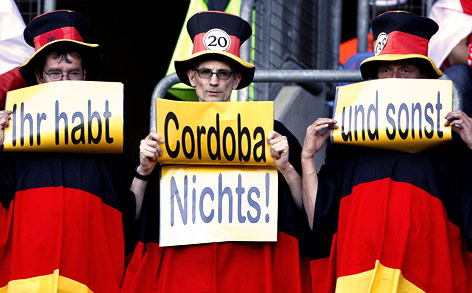And then, to top it all off, it seems like things about Austria just keep falling into my lap like ripe, perfect apples off of a tree. Here's the story of the most recent one.
A couple of weeks ago, a former Latin student of mine was visiting me and mentioned that she was learning how to sing a song in German in her choir class. I asked her how it was going, and she said that the choir and the choir teacher were feeling frustrated, because no one in the group knew how to pronounce any of the German words.
OPPORTUNITY!
Collaboration between disciplines!
Exposure to German culture and German class to students not already enrolled in German!
Grow the program!
Chance for my students to work at the top level of Bloom's Taxonomy by teaching what they were currently learning!
So, I contacted the choir teacher, who was thrilled to hear that we wanted to help out, and two days later my German 1 class in their 4th week of German was teaching the choir students how to pronounce the German words in Franz Schubert's Sanctus from the German Mass in G.
To prepare for this collaboration, I also did a little reading myself on Franz Schubert. Biography.com has a pretty good write-up on him. Turns out that ol' Franzie was Austrian by birth and lived most of his life there. He's buried at the Zentralfriedhof in Vienna. (I'm slapping myself for not visiting the Zentralfriedhof while I was in Vienna this summer. I guess you can't do it all.) I also learned that Schubert died at the age of 32. Wow! So young and so accomplished and full of genius!
I presented this to the students as part of the introduction to the collaborative lesson. Also, interesting to read were all of things that Schubert did not succeed at. I am pondering the idea that when we present famous figures in class, we do tend to gloss them up a bit. Maybe the students need to see the successes and the failures of the historical figures that we read and discuss. I'm definitely going to work on that.
Music was a significant piece to my experience with Austrian culture this summer. While in Innsbruck, I was able to attend a free outdoor concert, and it was extremely inspiring. I won't forget relaxing back into the recognizable classics and then being catapulted forward into new, innovative pieces that challenged my perceptions about orchestral music. (see: Melodies floating the summer air)
As an added bonus, the choir teacher is going to look into doing a holiday lesson with my German 1 using some German songs like: O Tannenbaum, Stille Nacht, etc. If you have any suggestions for music/songs that we could easily use, please let me know!
So, thanks to my student who came to her teacher for help, which challenged me to turn my students into teachers for the day, while at the same time, I became a student again learning more about one of Austria's most famous composers.
 |
| Mozart garden in Vienna, 2013 |











